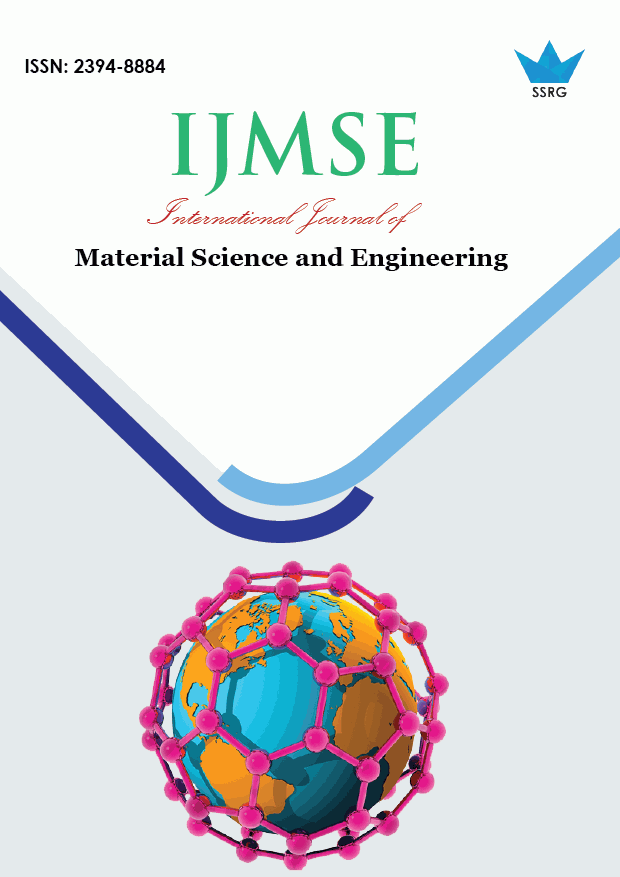First Principle Investigation of the Electronic and Optical Properties of TiCoSb: Consequences for the Photovoltaic Applications

| International Journal of Material Science and Engineering |
| © 2025 by SSRG - IJMSE Journal |
| Volume 11 Issue 1 |
| Year of Publication : 2025 |
| Authors : Solomon Tahiru Tonga, Festus Dickson, Joshua Ishaku Arewa, Ibrahim Isah, Hirhyel Asur Tarfa, Yohanna Jacob Baro |
How to Cite?
Solomon Tahiru Tonga, Festus Dickson, Joshua Ishaku Arewa, Ibrahim Isah, Hirhyel Asur Tarfa, Yohanna Jacob Baro, "First Principle Investigation of the Electronic and Optical Properties of TiCoSb: Consequences for the Photovoltaic Applications," SSRG International Journal of Material Science and Engineering, vol. 11, no. 1, pp. 16-21, 2025. Crossref, https://doi.org/10.14445/23948884/IJMSE-V11I1P103
Abstract:
TiCoSb, a half-Heusler semiconductor, has been investigated for its electronic and optical properties using first principles Density Functional Theory (DFT) implemented on the quantum espresso code. The structure was relaxed until the ground state was obtained. All calculations were carried out using the projector augmented wave method, the Generalized Gradient Approximation of the Perdew Burke Erzheholf (GGA-PBE). The band structure analysis reveals a moderate band gap of 1.08 eV, which indicates the material’s ability to absorb light at lower energy. The Projected Density of States (PDOS) confirms strong hybridization between Ti-3d, Co-3d, and Sb-3p orbitals, influencing electronic transport properties. Optical property investigations show that TiCoSb exhibits high absorption in the visible range (1.5-5 eV), comparable to conventional photovoltaic materials such as Si and GaAs. The real and imaginary dielectric functions indicate strong interband transitions, while the low reflectivity enhances light-absorption potential. The refractive index (2.5-3.5) supports efficient light trapping, and the energy loss function suggests moderate carrier transport, suitable for photovoltaic applications. Comparative analysis with well established photovoltaic materials suggests TiCoSb could be a viable solar absorber since its band gap is direct and optimized for efficient charge carrier extraction.
Keywords:
TiCoSb, Half-Heusler, First principle DFT, Optical Absorption, Photovoltaics.
References:
[1] Anam Kalair et al., “Role of Energy Storage Systems in Energy Transition from Fossil Fuels to Renewables,” Energy Storage, vol. 3, no. 1, 2021.
[CrossRef] [Google Scholar] [Publisher Link]
[2] Phebe Asantewaa Owusu, Samuel Asumadu-Sarkodie, and Shashi Dubey, “A Review of Renewable Energy Sources, Sustainability Issues and Climate Change Mitigation,” Cogent Engineering, vol. 3, no. 1, pp. 1-14, 2016.
[CrossRef] [Google Scholar] [Publisher Link]
[3] Janusz Nowotny et al., “Towards Global Sustainability: Education on Environmentally Clean Energy Technologies,” Renewable and Sustainable Energy Reviews, vol. 81, no. 2, pp. 2541-2551, 2018.
[CrossRef] [Google Scholar] [Publisher Link]
[4] Rashid Dallaev et al., “Overview of the Current State of Flexible Solar Panels and Photovoltaic Materials,” Materials, vol. 16, no. 17, pp. 1-32, 2023.
[CrossRef] [Google Scholar] [Publisher Link]
[5] Olivia M. Pavlic, “Discovering and Understanding High Performance Materials Using Density Functional Theory: Quantum Mechanical Simulations and the Consequences of Symmetry,” Graduate Theses, West Virginia University, pp. 1-183, 2023.
[CrossRef] [Google Scholar] [Publisher Link]
[6] Ntalane S. Seroka, Raymond Taziwa, and Lindiwe Khotseng, “Solar Energy Materials-Evolution and Niche Applications: A Literature Review,” Materials, vol. 15, no. 15, pp. 1-18, 2022.
[CrossRef] [Google Scholar] [Publisher Link]
[7] Rajan Walia et al., “Defect Engineering for Tailoring Thermoelectric Properties of Electroceramics,” Defects Engineering in Electroceramics for Energy Applications, pp. 181-225, 2024.
[CrossRef] [Google Scholar] [Publisher Link]
[8] Bin Xu et al., “Electronic and Optical Properties of Ticosb Under Different Pressures,” Journal of Solid State Chemistry, vol. 192, pp. 351-355, 2012.
[CrossRef] [Google Scholar] [Publisher Link]
[9] B. Xu et al., “Electronic Structure and Assessment of Thermoelectric Performance of TiCoSb,” Materials Research Innovations, vol. 18, no. 2, pp. 104-107, 2014.
[CrossRef] [Google Scholar] [Publisher Link]
[10] Albert Polman et al., “Photovoltaic Materials: Present Efficiencies and Future Challenges,” Science, vol. 352, no. 6283, 2016.
[CrossRef] [Google Scholar] [Publisher Link]
[11] J.P. Perdew, K. Burke, and M.J.P.R.L. Ernzerhof, “Perdew, Burke, and Ernzerhof Reply,” Physical Review Letters, vol. 80, no. 4, 1998.
[CrossRef] [Google Scholar] [Publisher Link]
[12] M. Khalid Hossain et al., “Photovoltaic Performance Investigation of Cs3Bi2I9-Based Perovskite Solar Cells with Various Charge Transport Channels Using DFT and SCAPS-1D Frameworks,” Energy & Fuels, vol. 37, no. 10, pp. 7380-7400, 2023.
[CrossRef] [Google Scholar] [Publisher Link]
[13] Jeroen Brebels et al., “High Dielectric Constant Conjugated Materials for Organic Photovoltaics,” Journal of Materials Chemistry A, vol. 5, no. 46, pp. 24037-24050, 2017.
[CrossRef] [Google Scholar] [Publisher Link]
[14] Sadao Adachi, “Band Gaps and Refractive Indices of ALGaAsSb, GAInAsSb, and INPAsSb: Key Properties for a Variety of the 2–4- μm Optoelectronic Device Applications,” Journal of Applied Physics, vol. 61, no. 10, pp. 4869-4876, 1987.
[CrossRef] [Google Scholar] [Publisher Link]
[15] Jacob B. Khurgin, “Energy and Power Requirements for Alteration of the Refractive Index,” Laser & Photonics Reviews, vol. 18, no. 4, 2024.
[CrossRef] [Google Scholar] [Publisher Link]
[16] Shaomin Dan et al., “Transparent Epoxy/TiO2 Optical Hybrid Films with Tunable Refractive Index Prepared via a Simple and Efficient Way,” Progress in Organic Coatings, vol. 120, pp. 252-259, 2018.
[CrossRef] [Google Scholar] [Publisher Link]
[17] Peeyush Kumar Kamlesh et al., “Investigation of Inherent Properties of XScZ (X= Li, Na, K; Z= C, Si, Ge) Half-Heusler Compounds: Appropriate for Photovoltaic and Thermoelectric Applications,” Physica B: Condensed Matter, vol. 615, 2021.
[CrossRef] [Google Scholar] [Publisher Link]
[18] P. Borthen, and H.H. Strehblow, “X-Ray Reflectivity Fine Structure from Homogeneous Materials in the Hard-Energy Range,” Journal of Physics: Condensed Matter, vol. 7, no. 19, 1995.
[CrossRef] [Google Scholar] [Publisher Link]
[19] Xiao Nie et al., “Refractive Index and Extinction Coefficient of Hollow Microspheres for Solar Reflection,” Applied Physics Letters, vol. 118, no. 21, pp. 1-6, 2021.
[CrossRef] [Google Scholar] [Publisher Link]
[20] Tilak Das, Giovanni Di Liberto, and Gianfranco Pacchioni, “Density Functional Theory Estimate of Halide Perovskite Band Gap: When Spin Orbit Coupling Helps,” The Journal of Physical Chemistry C, vol. 126, no. 4, pp. 2184-2198, 2022.
[CrossRef] [Google Scholar] [Publisher Link]

 10.14445/23948884/IJMSE-V11I1P103
10.14445/23948884/IJMSE-V11I1P103